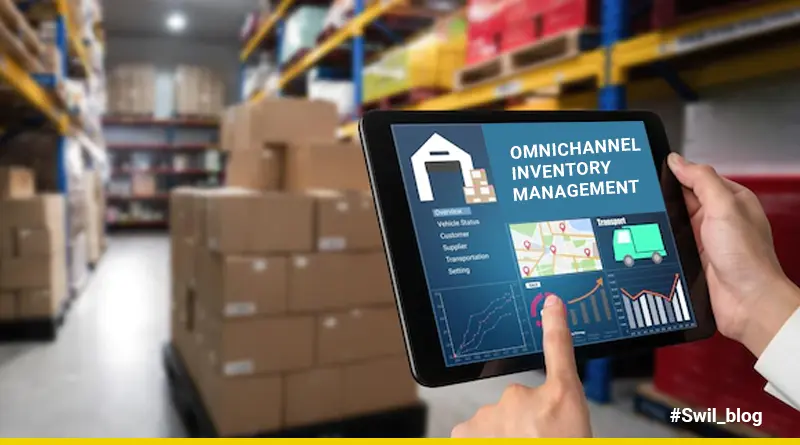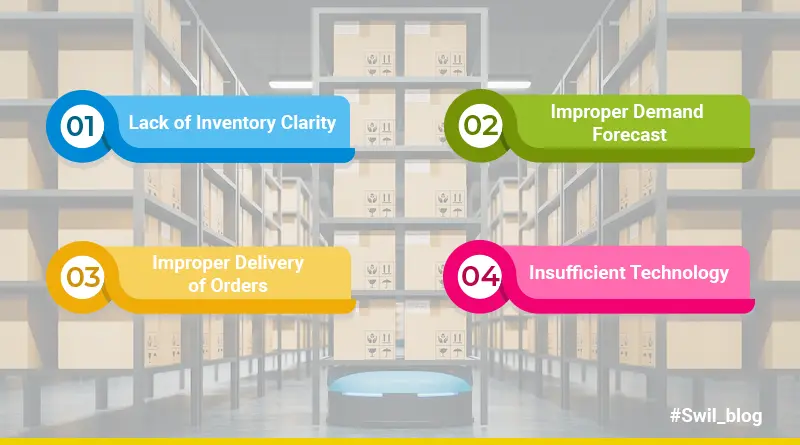For retailer stores with a strong brick – and – mortar presence, the biggest challenge is to rethink the inventory model from a warehouse – to – store model to an Omni – channel model. This requires a radical change in the mindset of the entire enterprise. It consists of product mix, procurement strategies, warehouse locations, inventory levels & shipping models.
Consider a scenario where a Jaipur customer orders a product that needs to be shipped from a warehouse in Gujarat. But, the same item can be delivered from a store in downtown Jaipur, or it can be picked up by the customer at the curb. Sounds uncomplicated, right?
One of the abiding impacts of social distance guidelines on the retail industry is the transition to Omni – channel operations. Customers had to adjust their shopping habits from in-store to online buying. These experiences were reduced or eliminated by the pandemic. The salesperson recommendations have been replaced with shipping options and online reviews. Many of these restrictions have been lifted. Yet, the convenience of these alternatives will continue to meet customer expectations.
Implementing these services requires long-term operational transformation for retailers of all sizes. Simultaneous processing of store, online and mobile orders requires a new system. This requires a specialized inventory management system. Inventory strategies must be in place so retailers can continue meeting customer demands.
Article Content-
- What is an Omni channel approach?
- What is Omnichannel Inventory Management?
- Challenges of Omni channel inventory management
- Strategies to Optimize Omni Channel inventory Management
- Benefits of Omni Channel inventory Management
- Points to keep in mind before opting for an omni channel inventory management approach
- Conclusion
What is an Omni channel approach?
Omni – channel is a smooth kind of shopping experience. No matter whether you’re shopping online from your desktop or mobile device, over the phone, or in a physical store. It is a special multi – channel sales approach. Omni – channel approach means the integration of sales, promotions, and communication channels on the back end.
For example, a customer service employee interacting with a customer in a store. It’s an Omni – channel approach when they can capture a customer’s past purchases and preferences with a single click. Or, you can use your desktop computer to check inventory for each store on your company’s website. Later, use your smartphone or tablet to buy the item or pick it up at your chosen location.
The Omni-channel approach improves customer service by offering many communication options. Back – end integration of channels is very essential in an Omni – channel approach. It gives customers greater flexibility because they can switch channels during a dialogue. It’s a known fact that companies are no longer competing not only for the quality of their products, but also for the quality of the customer experience they can deliver.
What is Omnichannel Inventory Management?

Omni – channel inventory is inventory management across many sales channels. This includes brick-and-mortar stores, online stores, mobile pop-ups, and even social media companies. Omni-channel inventory management software allows retailers to track inventory levels well. It also analyzes data, and automates tasks across many sales channels. All this is done from a single platform.
Real – time inventory control is the key to enabling an Omni channel retail experience. Retailers need systems that can spread to locations, platforms, and technologies. Failure to keep up with order and inventory levels can reduce a company’s growth. This will cost the business. Predicting patterns for proper storage of supplies is a hurdle faced by retailers.
Demand forecasts have become more complex now. As customers request products through many channels. It sounds simple to provide inventory to customers whenever required. Here the majority of the work is done in the backend. This reveals the weaknesses of traditional inventory management methods.
Omni – channel inventory management means providing an infrastructure that allows customers to shop the way they choose. Some examples of Omni channel inventory management include:
- Item bought at the store
- Item bought at the store for home delivery
- Item bought online for home delivery
- Item bought online for pickup
- Item bought using mobile app
It doesn’t matter what shopping method customers choose. What matters most is a consistent and seamless experience. Unfortunately, all these various shopping channels and fulfillment options. They can add infinite complexity to your inventory management. These can cause a myriad of problems before your order is delivered. Hence, a well-defined inventory management should be in place.
Challenges of Omni channel inventory management

To deliver the goods as expected, retailers need to procure the right inventory from the right storage location. For this, they need to use the ideal shipping method or logistic partner. Retailers also need to track items from the top of the supply chain to delivery. They also need to keep customers up to date in the process. And of course, payment should be easy. Otherwise, you run the risk of emptying your shopping cart with unpurchased items. Split orders from many depot locations or suppliers make on-time delivery even tougher.
Some of the most common reasons consumers are disappointed with online shopping:
- Delayed delivery
- Lost and found
- Inaccurate tracking
- Wrong article
- Bad packaging
Customers won’t return to your store after having a negative experience with your brand. Thus, you need to expect these issues and make a plan to manage the complexity of your Omni -channel inventory. Below are some of the most common challenges for an Omni – channel inventory management.
Lack of Inventory Clarity
Accurate inventory tracking is difficult. This is due to the large number of ordering channels and suppliers. The company’s total in – hand inventory includes items stored in its depot, fulfillment center inventory, and in – transit inventory. An integrated system is required to collect and organize data. Without this, accurate inventory visibility is impossible.
Improper Demand Forecast
Many factors influence demand forecasts. This includes seasonal sales cycles, commodity prices, and macroeconomic factors. Accurate demand forecasting aids optimal inventory levels and shipments of products. This is done at the most profitable prices on the market. For a proper forecast, you need to collect and analyze historical sales, orders and turnover data. For this, you need an Omni – channel inventory management system. This will help integrate data from many business functions.
Improper Delivery of Orders
Order accuracy is the key to customer satisfaction and profitability. Orders that contain wrong items or orders sent to the wrong customer, increases correction cost to a significant level. This will wipe out the rate of return. To improve the accuracy of Omni channel order management, rank automation and phase out manual and paper – based processes. Make use of technologies such as barcode scanning, electronic data interchange, and automated delivery notifications.
Insufficient Technology
Omni – channel inventory management isn’t possible without the right system support. Without integrated systems that provide real – time data, an Omni – channel inventory won’t succeed. Review inventory flaws of your business and look for digital solutions that can help you tackle them.
Strategies to Optimize Omni Channel inventory Management

Integrated supply chain
Omni channel inventory management software connects different parts of the supply chain. The software you choose should be integrated with software solutions such as accounting, management channels, and distribution.
Maintain true visibility
Inventory data must be stored across all sales channels in the product management system. Product counts are updated online across channels so you know exactly what’s on sale and where. This feature reduces the risk of running out of inventory. All data should be stored in software to create an accurate flow of information between channels. It is used for later reporting and further optimization.
Friendly return policy
Treat your earnings with the respect they deserve. Don’t think of them as an outcome of internet sales. Establish a fair and transparent return policy. Communicate this policy to your customers. Their goal is to make product returns easy and organized. This process is beneficial to both buyers and retailers.
Focus on Customer Satisfaction and Experience
When trying to improve Omni – inventory management, always think about your customers. Using digital techniques can help you get customers. Yet, it is a customer – centric approach that helps keep customers. Improving methods and systems can help reverse trends. If all improvements combine with the goal of improving the customer experience, it takes your brand to a new level.
Benefits of Omni Channel inventory Management

Tracking
With the latest inventory management system, companies can track warehouse and transit items. Inventory software with barcode scanning or EDI capabilities provides you with several benefits. It allows you to locate an item by SKU, serial number, batch, location or order number. This accurate location tracking allows you to keep your customers up-to-date with order status. It also saves you the hassle of tracking items through the reverse logistics for returns and recalls.
Optimized Tracking
With the latest inventory management system, companies can track items in the warehouse and in transit very accurately. For example, inventory software with barcode scanning or EDI capabilities allows you to instantly locate an item by SKU, serial number, batch, bin location, or order number. This accurate location tracking allows you to keep your customers up-to-date with order status. It also saves you the hassle of tracking items through the reverse logistics chain for returns and recalls.
Reduced costs
Inventory costs, or storage costs for goods, make up 25 to 30 percent of total inventory. It represents a major supply chain cost that impacts the cost of the goods sold. This in turn reduces profits. Combining inventory levels with business insights allows retailers to pursue slimmer inventory operations. This is done by adjusting inventory levels, reorder points, and fulfillment contracts. Hence, inventory management costs are reduced at a higher order – to -fulfill rate. This is done without sacrificing profit margins.
Improved relationships with suppliers
An integrated inventory system makes it easy to share relevant data with suppliers. You can use the platform to receive automatic updates for incoming goods. Besides, you can merge suppliers and sourcing information in one place. You can gain insights and rank your relationships with the most beneficial suppliers. Also you can renegotiate contracts to reduce costs.
High Customer Satisfaction and Retention
A retail fulfillment process that leverages multi – channel sales opens many shopping channels. As a result, these customers are likely to be happy with your brand and will come back in search of more.
Points to keep in mind before opting for an omni channel inventory management approach

1. Count your inventory
Before you start working on your system, you need to have a good view of where you are standing. First, analyze your current inventory management. Think about how your supply chain works and what you do to track your inventory. Divide your resources and use the appropriate technology.
2. Research about omni – channel business software options
This should give you an idea of where the greatest potential for improvement lies. Find the one that brings the greatest value to your business. Then choose the appropriate one that matches your business.
3. Quality shopping and user experience should be your top moto’s
When implementing a new solution, make sure you are not implementing it just for the sake. Make changes to improve the customer experience
Conclusion
Nowadays, no one buys in a single way. People of all ages buy online, offline and on the market from well – known manufacturers and independent local brands. The inference that can be drawn from this is simple. Revenue is generated from different sources and different devices. Inventory management is very important for many reasons.
Prevent overstock and understock problems. Always maintain customer satisfaction and increase brand awareness. This will, of course, bring more benefits than ever before. And most importantly, it saves you a lot of headaches. To stay ahead of the competition, especially in the competitive retail industry, you need to manage your inventory. This is regardless of the channel you’re selling.
In fact, poor inventory management can cause your financial downturn and ruin your business later, if not immediately.





